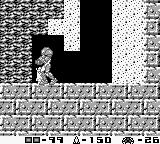Retro Replay Review
Gameplay
Metroid II: Return of Samus refines the exploration-driven formula that defined its NES predecessor, translating it to the portable Game Boy with remarkable finesse. Players assume the role of bounty hunter Samus Aran as she traverses the hostile caverns and biomes of planet SR388, seeking out the last remnants of the Metroid parasite. The game emphasizes non-linear progression, prompting players to scour every nook for power-ups—missile expansions, energy tanks, and suit enhancements—that unlock new traversal abilities and secret areas.
(HEY YOU!! We hope you enjoy! We try not to run ads. So basically, this is a very expensive hobby running this site. Please consider joining us for updates, forums, and more. Network w/ us to make some cash or friends while retro gaming, and you can win some free retro games for posting. Okay, carry on 👍)
The core loop of exploration, combat, and backtracking remains engaging throughout. Unlike the original Metroid’s sprawling map, Metroid II features a more compartmentalized environment that still rewards patience and observation. New Metroid variants introduce tactical considerations: some are nimble and require precise missile timing, while others demand methodical bomb deployments in Morph Ball form. These encounters keep the tension high, as running out of missiles or health mid-fight can force a nerve-wracking retreat.
Controls are tight and responsive on the Game Boy’s modest hardware. Samus’s movement feels weighty, yet agile enough to navigate narrow tunnels and deadly traps. The Morph Ball mechanic, which lets her roll through tight passages and deploy bombs, is used judiciously throughout the adventure. While the absence of an in-game map display means you’ll rely on memory or hand-drawn sketches, the game’s clever visual cues—such as distinct wall textures and unique room layouts—help orient dedicated explorers.
Graphics
Graphically, Metroid II works within the Game Boy’s monochrome palette to deliver surprisingly clear and atmospheric visuals. Each region of SR388—from the ice caverns to the volcanic core—features unique sprite designs and tile sets that prevent the world from feeling repetitive. Samus’s detailed suit sprite stands out crisply against the background, making it easy to track your position during fast-paced sequences.
The various Metroid forms are impressively animated given the system’s technical constraints. Larval Metroids slither menacingly across the floor, whereas airborne variants flit unpredictably, evoking genuine unease. Enemy behaviors and attack patterns are communicated through sprite animation frames, ensuring that even with only four shades of gray, the action remains readable and fair.
Environmental hazards—spikes, lava pits, and crumbling platforms—are clearly delineated, allowing skilled players to execute precise jumps without frustration. The game’s hardware limitations mean there’s occasional sprite flicker when too many objects appear on-screen, but dedicated play sessions quickly reveal that its visual storytelling and level design far outweigh these minor technical hiccups.
Story
Metroid II’s narrative is succinct yet effective, picking up shortly after Samus’s victory over Mother Brain. The Galactic Federation’s warning that Metroids may still exist on SR388 establishes immediate stakes: if these parasitic creatures mature and reproduce, the galaxy faces annihilation. As Samus descends deeper into the planet’s bowels, the sparse text logs and brief mission updates foster a sense of isolation that defines the series’ tone.
Rather than relying on cutscenes or dialogue-heavy exposition, the game conveys story through environmental details and boss encounters. You’ll sense the mounting threat as you face mutated Metroids more aggressive than ever before. The quiet tension is palpable in the minimalist presentation—each defeated Life Metroid brings you closer to the ominous Core, where the ultimate confrontation awaits.
The ending sequence, though brief, delivers an emotional punch. When Samus rescues the infant Metroid instead of destroying it, players are left to ponder the consequences of mercy and the nature of the creatures she has been tasked to eliminate. This moment of moral ambiguity elevates the game’s narrative far beyond a simple “monster hunt,” foreshadowing the franchise’s later emphasis on Samus’s complex relationship with her most iconic adversary.
Overall Experience
Metroid II: Return of Samus stands as a landmark achievement in portable gaming, offering a deep, rewarding adventure on hardware often dismissed as limited. Its blend of exploration, tension-filled combat, and atmospheric design makes for an engrossing journey that rivals many home-console titles of its era. For fans of Metroidvania-style gameplay, this chapter provides a compact but richly detailed sandbox to conquer.
While the lack of a built-in map and the monochrome display may initially deter casual players, perseverance reveals a tightly constructed world that challenges your memory, observational skills, and strategic thinking. The game’s relatively short runtime—typically around six to eight hours for a first playthrough—ensures that the pacing stays brisk, with little filler content to pad the experience.
In retrospect, Metroid II laid critical groundwork for future series entries, introducing narrative complexity and creature design that would influence games like Super Metroid and beyond. As a portable title, it retains a timeless quality: every jump, missile strike, and corridor discovery still thrills. Whether you’re a longtime Metroid aficionado or a newcomer seeking an atmospheric action-adventure on the go, Return of Samus delivers a memorable odyssey into the heart of darkness on SR388.
 Retro Replay Retro Replay gaming reviews, news, emulation, geek stuff and more!
Retro Replay Retro Replay gaming reviews, news, emulation, geek stuff and more!









Reviews
There are no reviews yet.